Magnavox
Odyssey
Released in 1972

The
Magnavox Odyssey is the first home video game console, predating the Atari PONG
home consoles by three years. The Odyssey was designed by Ralph Baer, who had
a working prototype finished by 1968. This prototype is affectionately known as
the "Brown Box" to classic video game hobbyists. Unlike most video game
consoles, the Odyssey is analog rather than digital, which makes its invention
all the more amazing in spite of its rather crude graphics and controller responsiveness.
Also, unlike any conventional console today, this system was powered by batteries.
The Odyssey and its variants also lack sound capability (hence a silent console),
which was not uncommon in early PONG systems of that era.
The
Odyssey was released in May 1972. While it did not perform badly, it did not take
long before it succumbed to poor marketing by Magnavox retail chains. One of their
mistakes was misleading consumers into believing that the Odyssey would work only
on Magnavox televisions. It did, however, prove that consoles for the home could
be designed.
Atari PONG
Released
in 1975
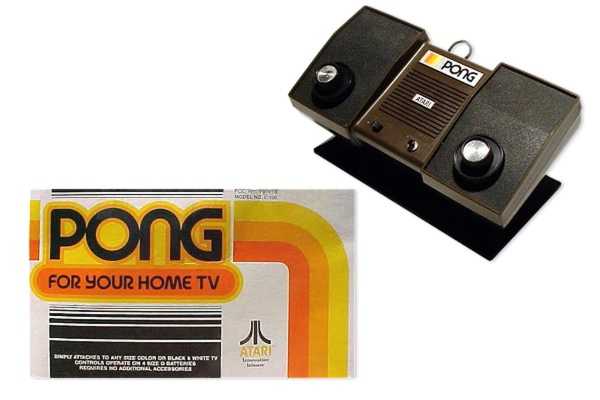
In
1973, after the success of the original PONG coinop, an Atari engineer by the
name of Harold Lee came up with the idea of a home PONG unit. Since the PONG coinop
that Alan Alcorn designed was nothing more than the game board connected to an
actuall televsion set, he thought it would be possible to scale it down a bit
and modify it for use at home. This would be a new direction for the fledgling
Atari consumer electronics. If they could pull it off, they would be one of the
pioneers of using high tech custom integrated circuits in the consumer industry.
In
1975 it was decided Sears would sell PONG under it's own specically created Tele-Games
lable, and production was initially projected at 50,000 units. This was soon raised
to 150,000 for the 1975 Christmass season. Atari agreed to give Sears exclusive
rights for the following year, and would continue to make custom Tele-Games versions
for any future consoles. This was the beginning of a long relationship between
Atari and Sears, which would continue even after Nolan Bushnell sold Atari to
Warner.
Magnavox Odyssey
100
Released in 1975
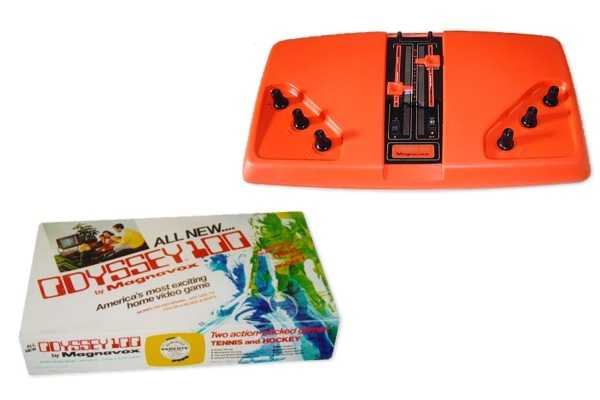
The
Odyssey 100 was an analog system which used four Texas Instruments chips. It did
not use cartridges and played two games: TENNIS and HOCKEY. A simple switch selected
the games, and the system was either powered by six batteries, or by an AC adaptor
(such power supplies were widely used by other systems).
The
Odyssey 100 was very basic and didn't have the common features of the million-seller
PONG systems of the next years. The knobs were fixed: there were no detachable
controllers yet. There was no digital on-screen scoring: the players marked their
score using two little plastic cursors on the system. The serve couldn't be changed:
it was automatic. This could seem strange compared to the first Atari PONG systems
which already had digital on-screen scoring. In fact, this was just a question
of technology. On-screen scoring would have required additional components, which
would have increased the cost of the system. Nevertheless, on-screen scoring was
added in later systems although the first attempts used archaic graphics. The
first Magnavox system to offer digital on-screen was the Odyssey 300 in 1976.
Magnavox
Odyssey 200
Released in 1975

Still
in 1975, Magnavox released an improved version of the Odyssey 100: the Odyssey
200. It was same as the Odyssey 100 but with two additional chips from Texas Instruments,
which added a third game called SMASH and some on-screen scoring. The Odyssey
200 could be played by two or four players (first system to offer this feature),
and displayed very basic on-screen scoring using small rectangles (it still had
the two plastic cursors to record the scores). Each time a player marked a point,
his white rectangle would shift on the right. The winner was obviously the first
whose rectangle would reach the rightmost position on the screen. Although the
scores were not yet digital, the Odyssey 200 remained more advanced than the first
home version of Atari PONG because it played three different games for two or
four players.
1975
marked the begining of a long history. Both Atari and Magnavox released their
systems, and more advanced ones were to come.
Atari Super
PONG
Released in 1976
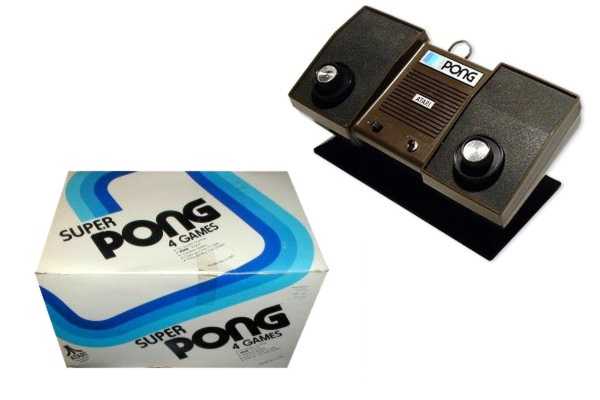
Atari's
sales of the Home PONG console were phenomenal to put it mildly. Atari would continue
to cash in of the PONG franchise by releasing yet another home version of one
of its arcade game assets. This time it would be Super PONG. Now home players
could select for 4 different variations of PONG games to delight and entertain
them for countless hours.
Meanwhile
numerous knock-off PONG-type consoles were hitting the market. However, because
of Atari's now well known presence in the Coin-op market, its name recognition
helped it stand out. Also Atari's unusual Pedestal design helped Atari stand out
in the Sears Retail Stores as well as other stores who were now carrying Atari
products.
When
compared to the plethora of bland and boxy "Me-Too" consoles by so many
other companies, the Atari PONG line of consoles simply stood out. Atari's consoles
had eye catching rainbow colors and a deep and ear catching PONG sound from their
built in speaker. Most other consoles were still far behind playing catch up with
Black & White displays, flimsy controllers and some even without sound.
Coleco
Telstar
Released in 1976

Telstar,
Coleco's first video game system, was released in 1976 and played only three games
with three difficulty levels. It was the first system to use GI's AY-3-8500 chip
and was a real success: over a million units were sold.
The
AY-3-8500 chip played six games with more difficulty levels, and the games could
also be played in color. It was pretty obvious that Coleco would release more
systems. At least 15 different games were released in two years with the only
differences between the "pong" systems being the number of games, the
way the difficulty levels were used, and the type of pictured (color or black
and white).
An
amazing detail is the way Coleco packed their video game systems, they were sold
partially assembled. The systems were electronically ready to play, but the users
had to put on the knobs and stick the decorative stickers on the plastic case.
So far, only Coleco is known to have released their systems this way. It is believed
that this was done to save on assembling costs.
Coleco Telstar
Classic
Released in 1976
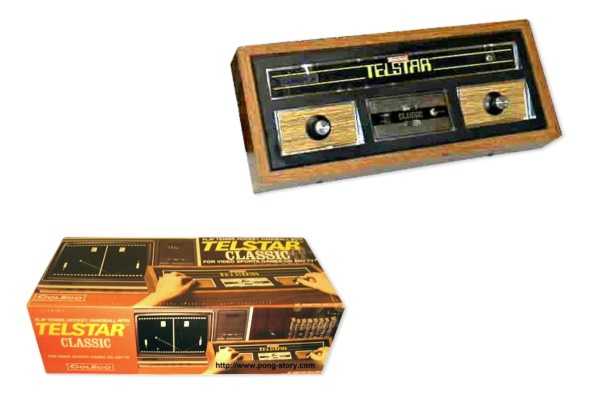
The
Telstar video game console produced by Coleco first went on sale in 1976. It was
a video tennis clone simular to Pong. With a price of $50, budget minded consumers
loved it. Coleco sold over 1,000,000 units in 1976.
Released
the same year as the original Telstar, the Telstar Classic unit was essentially
the same as the Telstar. It simply added a clasic '70's woodgrain case to it.
This unit allowed 3 games (Tennis, Hockey, Handball) and 3 different skill levels.
In
the Christmas season of 1977, nine new designs of the Telstar were released, each
of them doing virtually the same thing. It was labeled "Video Sports"
with four different games, all of them PONG clones. During it's lifespan, Coleco
had produced about nine different variations of thier machine and tossed about
one million 'obsolete' machines.
Magnavox Odyssey
300
Released in 1976

Magnavox
used several Texas Instruments chips, each having a special function (collision
detection, on-screen scoring, etc). Atari had the advantage of using the first
chips often called "PONG in a chip", but the chips were not available
to other manufacturers. Each different Atari system used a special chip. Of course,
a few discrete components interfaced the chip to the system (video modulator,
player controls, etc). These chips replaced most of the numerous components used
in analog and digital systems. Although Atari chips were a smart design, the idea
of integrating complex circuits into a single chip was a common idea at that time,
and other video game manufacturers would soon release their own video game chips.
Magnavox
continued with the Odyssey 300 in 1976, which was one of the first system to use
a single game chip containing the major circuitry of a PONG system (after the
1975 Atari PONG system).
Magnavox Odyssey
400
Released in 1976

Still
in 1976, Magnavox released the Odyssey 400. It played the same games than the
Odyssey 200 and used an additional Texas Instruments chip to display digital on-screeen
scoring (it was the first analog Odyssey system to display digital on-screen scoring).
On-screen scoring was quite well designed. As a matter of fact, the scores were
large and were only shown when the ball was lost, and a large 'W' letter was displayed
on the winner's side when the games were over.
Like
the Odyssey 100 and 200, the Odyssey 400 used the same three knobs to move the
bats and control the "english" effect on the ball.
Magnavox
Odyssey 500
Released in 1976

The
Odyssey 500 was also released in 1976, and was very advanced for that time considering
the technology used. It was in fact the only system of its kind. As a matter of
fact, the white paddles representing the players were replaced by simple color
graphics: two tennis players with their rackets (TENNIS game), two squash players
(SQUASH), or two hockey players holding their sticks (HOCKEY).
Magnavox
released the Odyssey 2000, 3000 and 4000 in 1977. The Odyssey 5000 was planned
but never released. It was designed to play 24 games (7 different types) for two
or four players. The Odyssey 4000 was the last PONG system released by Magnavox.
Fairchild
Channel F
Released in 1976
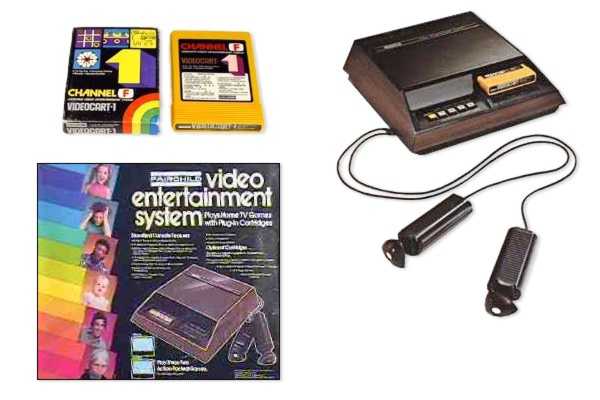
The
Channel F was the first programmable video game system, having plug-in cartridges
containing ROM and microprocessor code rather than dedicated circuits. Not a very
popular or entertaining system, it was nonetheless important at the time for having
a number of original features which were copied by later more successful systems.
Fairchild
released twenty-six different cartridges for the system, with up to four games
being on each cartridge. The games included sports, such as Hockey, Tennis and
Baseball, educational, such as Maths Quiz, board games, such as Checkers, and
shooting games, such as Space War. The cartridges had labels that contained the
game instructions on them and each were given a sequential number. In this respect
Fairchild started a trend in trying to boost game sales by numbering them and
so appealing to consumers who wanted to complete their collection.
The
Channel F console's popularity lowered when the Atari released their VCS in 1977
as the VCS had much better graphics, games and sound.
RCA
Studio II
Released in 1976

RCA
could not accept the fact that they let the Odyssey slip through there fingers
(Ralph Baer the designer of Odyssey approached RCA with the deal first), and into
the hands of there TV rival Magnavox. The RCA Studio II was their answer to the
Magnavox Odyssey. Released in 1976 a few months after the release of the Fairchild
Channel F, it would have been the first programmable console (Fairchild beat them
to the release gate).
The
console was doomed from the start. The lack of a color display and control paddles
made the unit old and dated. With only 8 games released, the Studio II suffered
the same fate as Channel F. Overshadowed and rendered obsolete by the Atari VCS
/ 2600
The
RCA Studio II should have been a color console, a few games were designed for
color, but the video output of the console was black & white. A Studio II
clone released in the UK called The Sheen M1200 was released in 1978, and produced
PAL color with RCA Studio II games and was a more successfull unit.
Atari
Video Pinball
Released in 1977
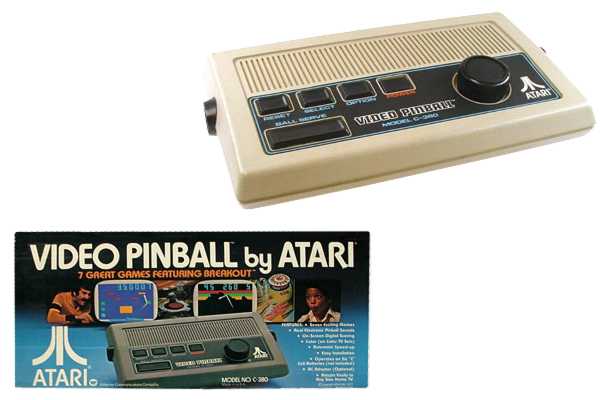
In
1977, Video Pinball appeared as another Atari coinop to standalone home console
translation by bringing the game Breakout to home players. Offered first in the
late '70's Atari "first edition release" standard woodgrain (also to
be used on the Atari 2600) and then a second edition white molded plastic model.
Bumper controllers on the sides or a dial on the front were used to control the
games depending on the game selected. There were three game types - Pinball, Basketball,
and Breakout.
Interestingly
enough, Atari did follow up with an actuall Video Pinball coinop, two years after
the release of their home console. It was a unique hybrid between video game and
pinball technology that still has not been duplicated to this day. While some
before and after tried using the video game part as a game within the game or
simply to display unique animations (such as Baby Pacman, or the more recent Star
Wars pinball hologram effect model), this was the first to actually use both technologies
as an integral part of the game play.
Atari Stunt Cycle
Released in 1977

All
the thrills and chills of real stunt motorcycle riding right in your home living
room, so much fun Evil Knevil must have had one! (Well... maybe). Stunt Cycle
originally was an Atari arcade coin-op, then made into a standalone console shown
here.
The
original coin-op had been released in 1975 to take advantage of the then popular
motorcycle stuntman Evel Knievel. Originally a motorcycle salesman who began doing
stunts to draw attention to his store, by the early 70's he was a household name.
Atari's coin-op attempted to capture the feel and fun of the stunt jumping Evel
Knievel was famous for, and was a mild success.
Stunt
Cycle gave the player a first person feel of riding a motorcycle, even though
the image on the screen wasn't first person. You could jump cars and buses, if
you played with the controls just right you could jump right off the screen, lots
of fun!
Atari VCS 2600
Released
in 1977
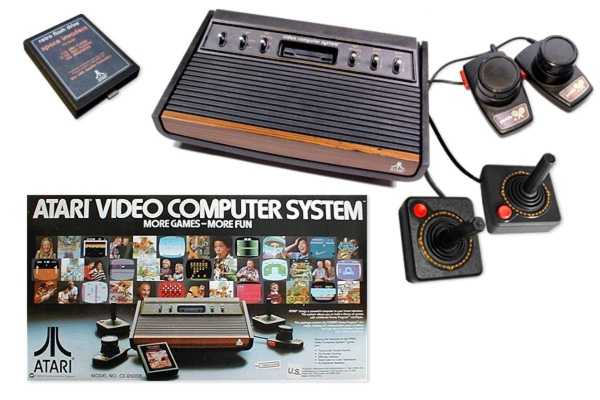
The
Atari 2600, released in 1977, is the first successful video game console to use
plug-in cartridges instead of having one or more games built in. It was originally
known as the Atari VCS, for Video Computer System, and the name "Atari 2600"
(taken from the unit's Atari part number, CX2600) was first used in 1982, after
the release of the more advanced Atari 5200.
The
initial price was $199 with a library of 9 titles. In a play to compete directly
with the Channel F, Atari named the machine the Video Computer System (or VCS
for short), as the Channel F was at that point known as the VES, for Video Entertainment
System. When Fairchild learned of Atari's naming they quickly changed the name
of their system to become the Channel F.
Atari
expanded the 2600 family with two other compatible consoles. The Atari 2700, a
wireless version of the console was never released due to design flaws. The Sleek
Atari 2800 released to the Japanese market in 1983 suffered from competition from
the newly-released Nintendo Famicom.
Coleco Telstar
Combat
Released in 1977
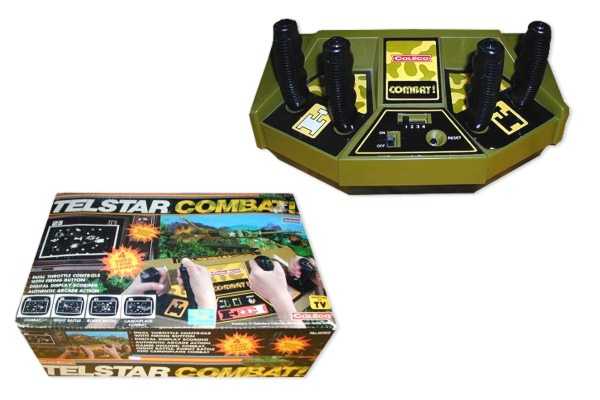
The
Coleco Telstar Combat! game was released in 1977 as a post-Pong dedicated video
game console. Unlike Coleco's earlier home Pong clones based on the General Instrument
AY-3-8500 chip, it used a AY-3-8700 chip. The console was a modest success but
due to having too many similar dedicated console products, Coleco nearly went
bankrupt in 1980.
Telstar
Combat was one of Coleco's attempts to break away from the Pong-clone video game
rut. It's certainly unique, no other company manufactured a dedicated console
with such elaborate controls. The console plays four variations of a tank battle
game, very similar to the Atari 2600 Combat game cartridge.
Coleco
Telstar Alpha
Released in 1977
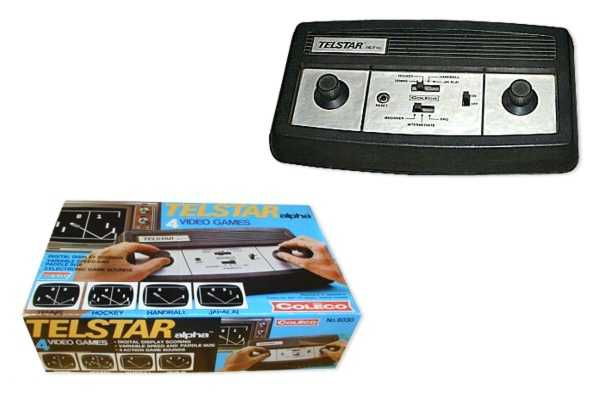
Coleco
cashed in on the Pong craze in a big way. They managed to grab a huge share of
the early home video game market partly through good marketing (their original
Telstar console was half the price of Atari's Pong) and partly through good luck
(Coleco was the only company that got their full shipment of the popular microchip
that everyone used to manufacture their home Pong systems in late 1976).
The
Telstar Alpha (model 6030) was released in 1977. It is a classic from Coleco,
and uses the AY-3-8500 game chip. The system plays 4 games in three difficulty
levels. It is the successor of the three older models (Telstar, Telstar Classic
and Telstar Ranger), and only differs by its case and fourth game (JAI-ALAI, also
known as SQUASH).
Like
the first Telstar, this system was sold in large quantities as it was cheap. It
was also released in Europe as the "Telstar Alpha Europa".
Magnavox
Odyssey 2000
Released in 1977

While
not the first electronic game, the earliest form of an electronic ping-pong game
dates back as a game played on an oscilloscope, by William A. Higinbotham at the
Brookhaven National Laboratory in 1958. His game was titled Tennis for Two.
In
1977, the Magnavox Odyssey line of PONG games represents the cutting edge of dedicated
console technology. The Odyssey 2000, 3000 and 4000 were arguably the most advanced
dedicated PONG console systems of the 1970's.
Magnavox Odyssey
3000
Released in 1977
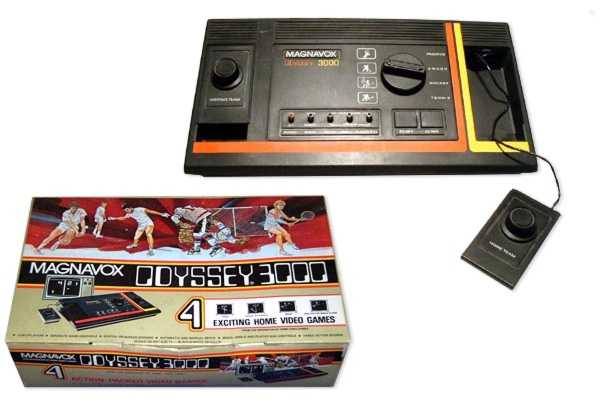
The
Magnavox Odyssey 3000 is another example of the Odyssey line for 1977. It is similar
to the 2000 offering the same games in a newly styled, more modern case. The Odyssey
3000 also featured detachable controllers which allowed more freedom when playing.
This was not a feature on the Odyssey 2000 model.
Magnavox
lead the PONG craze with its Odyssey line of consoles. In three years, the technology
had completely changed the PONG universe.
Magnavox
Odyssey 4000
Released in 1977

The
Odyssey 4000 was the last PONG system released by Magnavox. The Odyssey 4000 featured
8 exciting games in full color. The console also featured real joysticks like
those offered on other console models.
After
the Odyssey 4000, Magnavox goes on to release a completely different system known
as the Odyssey 2, also known as Videopac in Europe. This system was designed to
compete with Atari and Colecovision cartridge based game consoles.
Coleco
Telstar Colortron
Released in 1978
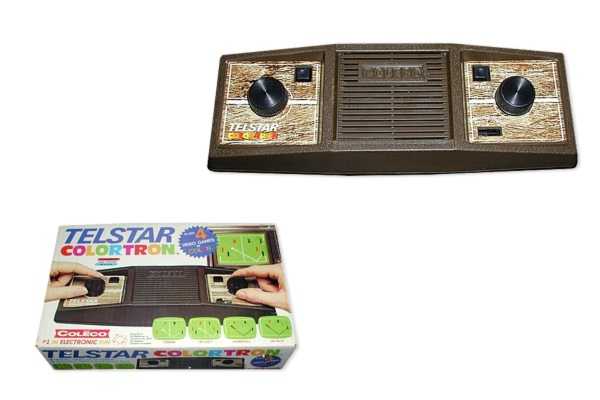
The
Telstar Colortron was released in 1978. It is one of the only systems based around
the AY-3-8510 game chip, a derivate of the AY-3-8500. The system offers 4 games
instead of 6, but the picture is in color, which is much better. Sound is not
unpleasant like on most of the other systems, since it comes from a little piezzo
beeper which produces a very discrete sound.
The
game selection is done using a push-button rather than a switch (easier to use
and more robust). Curiously, the system requires two 9V batteries: one for the
"video" (the games), and one for the "sound" (maybe the internal
circuitry of the piezzo beeper).
Coleco Telstar
Arcade
Released in 1978
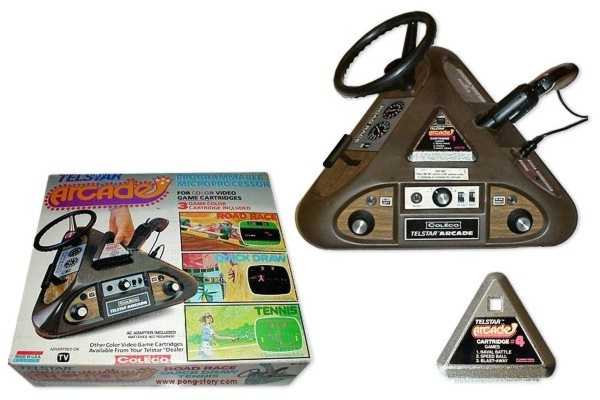
The
Telstar Arcade is maybe one of the most interesting systems made by Coleco, and
also the most advanced PONG system released in America, although it played non-PONG
games. Made in a triangular case, the system could play three types of games,
each being played on one of the three sides of the case. Obviously, the first
side allowed playing PONG games (TENNIS and the like), and the second side allowed
playing target shooting games. Nothing very different from most other systems,
except the gun storage. The third face was the most interesting: it allowed playing
car racing games. Very few systems offering that type of games were released at
this time, and the games were only played using rotary controllers or some sort
of joysticks.
Coleco
used a very uncommon cartridge format: a silver triangular case which connects
horizontally on the top of the console. Nothing in common with the other black
cartridges whith plug vertically. Coleco released only four cartridges. The first
one was sold with the system and the others were available separately for the
price of $25. Two flyers came with the system to order cartridges #2 and #3.
Bally
Professional Arcade
Released in 1978
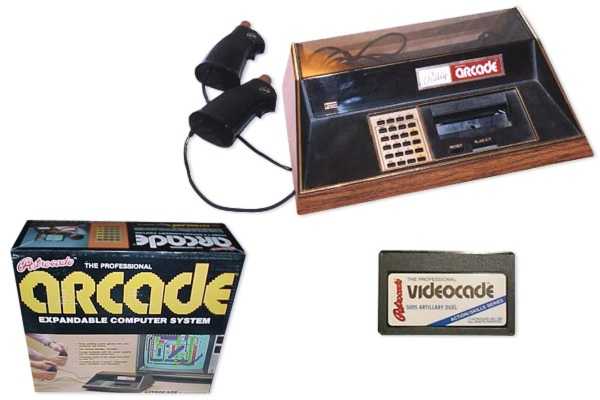
Released
in 1978, the Bally Professional Arcade was videogame maker Bally's only entry
in to the home console market, complete with typical late '70's woodgrain. The
little console from the 70's that just wouldn't die, it enjoyed several rebirths
similar to the Fairchild VES Channel F and significant homebrew/user following.
In
1972, Bally missed an early entry in to videogames, by telling one Mr. Nolan Bushnell
they were not interested in his Pong videogame. With Pong starting the video game
arcade revolution, by 1975 Bally decided to create a videogame division called
Midway (refered to as Bally/Midway) for the purpose of entering this market.
It
was decided to base the new console around the Zilog Z-80 microprocessor. A processor
making it's way in to arcade games and fast becoming the processor of choice in
the still developing microcomputer movement. The graphics system was to have an
advanced display system known as bitmapped graphics. In bitmapped graphics, each
pixel of the screen is mapped to a corresponding memory location.
Magnavox
Odyssey²
Released in 1978

In
1978 Magnavox came out with their second major system, the Odyssey², which
was totally different than the various Odyssey PONG systems. It was a computer
with BASIC programming, but many people regarded it as a home videogame console.
It came with two controllers, RF switch with TV box, power supply, and the Speedway,
Spinout and Cryptologic game cartridge.
The
Odyssey² was the first home video game console to introduce what was to become
the standard joystick design of the 1970s and 80s: a moderately sized black joystick
unit, held in the left hand, with an eight-direction stick that was manipulated
with the right hand. In the upper corner of the joystick was a single 'Action'
button.
The
area that the Odyssey² may well be best remembered for was its pioneering
fusion of board and video games: The Master Strategy Series. The first game released
was the instant classic Quest for the Rings!, with gameplay somewhat similar to
Dungeons & Dragons, and a storyline reminiscent of J. R. R. Tolkien's The
Lord of the Rings.
Coleco Telstar
Gemini
Released in 1978

1978
saw the release of the Coleco Telstar Gemini, which was totally diferent from
any other Telstar pong system preceding it. Looking like a common pong, it doesn't
play the common pong games. This unique sustem offered 2 shooting games along
with 4 pinball games.
This
console featured 2 flipper buttons on either side which simulated playing a real
pinball machine. There is also a big red button on top which was used to launch
the ball in to the playfield. The button simulated the real thing, a short tap
will shoot the ball out slowly and a long press will shoot the ball out faster.
There
were actually two completely different Coleco Gemini systems. The Telstar Gemini
shown here is the older and rarer machine. The other is an Atari 2600 clone by
Coleco called Gemini. Coleco probably did this to hide it from Atari's lawyer
armada. This worked for a while, but soon after the launch of the console Atari
unsuccessfully sued Coleco for braking copyright laws.
Zircon
Channel F System II
Released in 1979
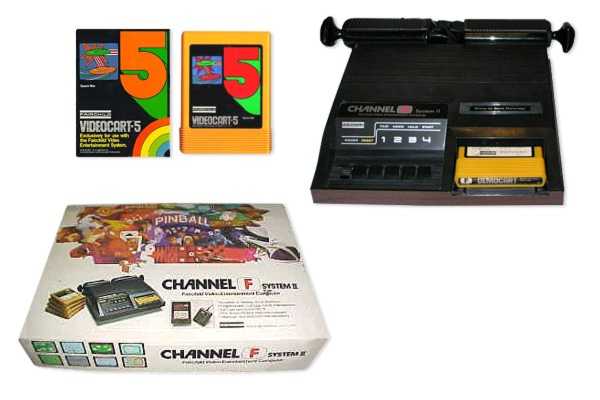
In
1979, a company by the name of Zircon bought all the rights to the Channel F.
What they had planned to do with them was not clear until when they released Fairchild's
scaled-down model as the $99 Channel F System II. Zircon also licensed it overseas,
where it appeared as the Saba Video Play in Germany, the Luxor Video Entertainment
System in Sweden, and the Grandstand in Great Britain. The System II model played
sounds through the TV set, rather than generating them through an internal speaker
(that's right: sounds in the System I model came from the unit itself). Channel
F System II also had removeable controllers.
By
1978, Fairchild had released 23 games the Channel F, with Zircon chipping in four
new titles a couple years later. The games run from single- to multi-game cartridges,
and various options for the games are selected by the 4 main buttons on the front
of the console. Probably the wierdest feature of the machine is that the games
are started by first turning on the console, then inserting the cartridge, and
hitting the reset button.
Mattel Intellivision
Released
in 1980
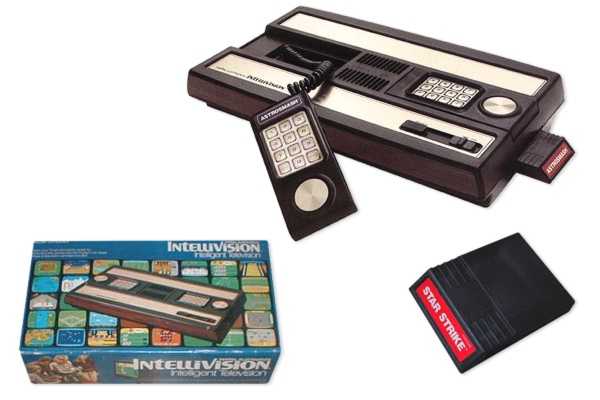
After
successful test marketing in 1979, Mattel Electronics released its Intellivision
system nationwide in late 1980. Armed with twelve games, better graphics and sound
than its competitors, and the promise to release a compatible keyboard that would
turn the system into a home computer ("Play games and balance your checkbook!"),
Mattel set its sights on taking down the "invincible" Atari 2600. They
got off to a good start, selling out the first production run of 200,000 Intellivision
units quickly.
Many
people bought an Intellivision with plans to turn it into a home computer when
the keyboard was released. There was a huge marketing campaign behind this (one-third
of the back of the Intellivision box was dedicated to the "Under Development"
keyboard), but months and then years passed without the keyboard being released.
Actually, it was released in a few test markets in late '81, but the price was
too high and the initial reaction poor. So in 1982, Mattel scrapped plans for
the infamous keyboard, but later (due to government pressure), they had to make
a computer add-on anyway.
Atari 5200
Released
in 1982

The
Atari 5200 is a video game console introduced in 1982 by Atari. It was created
to compete with the Mattel Intellivision, but it also competed with the Colecovision
shortly after the 5200's release. In some ways, it was both technologically superior
and more cost efficient than any console available at that time.
The
Atari 5200 was in essence an Atari 400 computer without a keyboard. This made
for a powerful, proven design which Atari could quickly bring to market. The system
featured many innovations like the first automatic TV switchbox, allowing it to
automatically switch from regular TV viewing to the game system signal when the
system was activated.
The
initial release of the system featured four controller ports, where all other
systems of the day had only two ports. The system also featured a revolutionary
new controller with an analog joystick, numeric keypad, two fire buttons on both
sides of the controller and game function keys for Start, Pause, and Reset.
Emerson
Arcadia 2001
Released in 1982
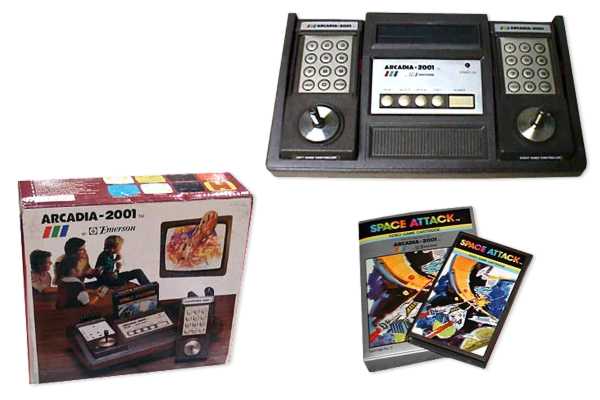
In
1982, the computer electronics company, Emerson, jumped into the gaming world.
They released the Arcadia 2001, a small cartridge-based system.The Arcadia 2001
controllers are similar in design to the Intellivison or Colecovision, with a
numeric keypad, a joystick, and two side buttons.
Emerson
Arcadia 2001 was supposed to be the Atari 2600 killer. A great console with great
games. Unfortunately they fell prey to complete lack of third party development,
and the lack of Arcade game titles. Similar to other consoles before it, they
were forced to release arcade clones.
The
system didn't grasp much attention, and soon found it's way to the bargain bin
at the cost of $99. The release of the Colecovision months later sealed the Arcadia's
fate. The Emerson Arcadia 2001 died after only a year and a half with 35 game
releases. Most never recall it existed.
Colecovision
Released
in 1982
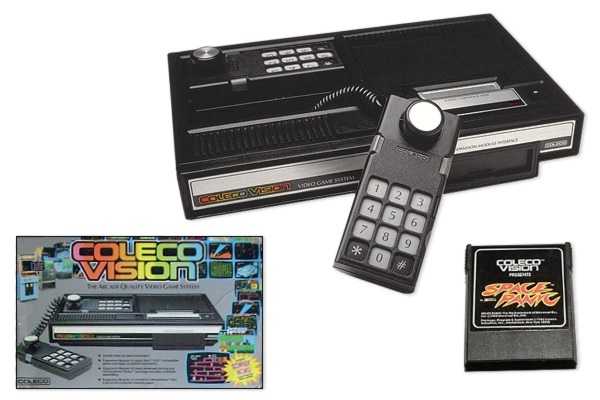
The
Colecovision is Coleco's third generation video game console, released in August
1982. It offered arcade-like graphics and controllers, and an initial catalog
of 12 titles, with 10 more promised titles on the way. All told, approximately
170 titles were released on plug-in cartridges during its lifetime. The controller
was a flat joystick, two side buttons, and a number-pad, which allowed the user
to put inserts for customized buttons. The majority of titles in its catalog were
conversions from coin-operated arcade games. The ColecoVision introduced two new
concepts to the home videogame industry - the ability to expand the hardware system,
and the ability to play other video game system games.
By
Christmas of 1982, Coleco had sold 500,000 units, mainly on the strength of its
bundled games. While Atari's fortune had risen on the popularity of Space Invaders,
Colecovision was the first console to feature the hit Donkey Kong, by Nintendo.
The Colecovision's main competitor in the next-generation console space was the
arguably more advanced but less commercially successful Atari 5200.
Coleco
Gemini
Released in 1982
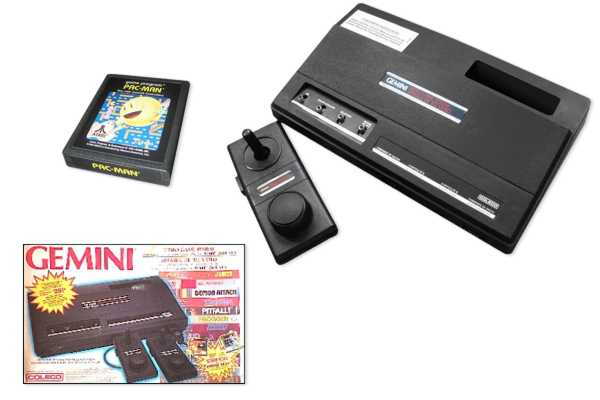
In
1982, Coleco released Expansion Module #1 for its Colecovision video game system
using off-the-shelf components. Atari sued Coleco for patent infringement, however
a court ruled that since Coleco used off-the-shelf components and not the same
components found inside an Atari 2600, the Expansion Module #1 did not infringe
on Atari's patents for the 2600. With this ruling, Coleco decided to make a stand-alone
Atari 2600 clone and named it the Gemini.
The
main difference between the Coleco Gemini and the Atari 2600 is the controller
design. The Coleco Gemini controllers featured an 8-way joystick and a 270-degree
paddle on the same controller (the joystick was at the top of the controller,
and the paddle was at the bottom of the controller). Unfortunately, if one wanted
to play the Atari 2600 game Warlords in 4 player mode, 2 sets of Atari-made paddles
were required, and one set of Atari-made paddles was required for 2 player paddle
games.
Mattel Intellivision
II
Released in 1982

Shortly
after the Intellivision I released nationwide in the United States, Mattel followed
up with the new updated Intellivision II unit in 1982. The product retailed for
$99.99 USD and showed a few marked improvements. In order to cut costs Mattel
featured 16 position removable joysticks on their 'new' system. A LED light was
implemented to show owners when the system was on or off, since this was a difficulty
with the Intellivision I unit. The power button functioned also as a reset switch
and must be held for 5 seconds before the power will shut off, otherwise just
pressing it will reset the system.
If
the game was not in play the screen would go dark after five minutes in order
to prevent burn in. To further reduce burn in, the Intellivision II Owner's Manual
states that you should play the system using low contrast levels on your TV anyhow.
To set the game on pause, you must simultaneously press 1 + 9 on the control pad.
The system caused problems when running certain Coleco brand games such as Donkey
Kong, Mouse Trap, and Carnival.
Nintendo Entertainment
System (NES)
Released in 1985
.jpg)
Following
a series of arcade game successes in the early 1980s, Nintendo made plans to produce
its own console hardware that had removable cartridges, a feature not included
with the company's earlier Color TV Games product. Designed by Masayuki Uemura
and released in Japan on July 15, 1983, the Nintendo Family Computer (Famicom)
was slow to gather momentum: during its first year, many criticized the system
as unreliable, prone to programming errors and rampant freezing. Following a product
recall and a reissue with a new motherboard, the Famicom's popularity soared,
becoming the best-selling game console in Japan by the end of 1984. Encouraged
by their successes, Nintendo soon turned their attentions to the North American
markets.
In
June 1985, Nintendo unveiled its American version of the Famicom at the Consumer
Electronics Show (CES). With a completely redesigned case and a new name, the
Nintendo Entertainment System (NES) proved to be just as popular in America as
the Famicom was in Japan, and played a major role in revitalizing interest in
the video game industry.
Atari 2600 Junior
Released
in 1986
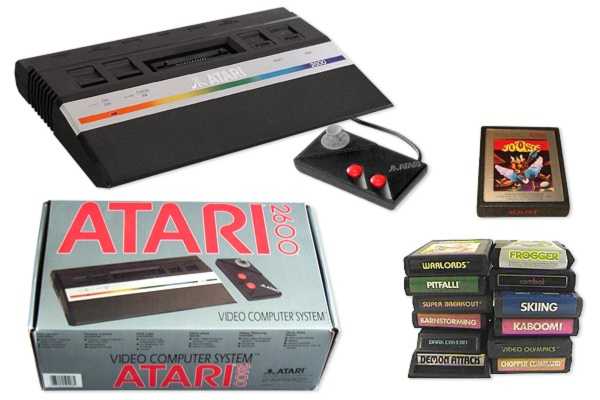
In
1986 the Atari 2600 was re-released as the 2600 Junior. They retailed for $49.99
and came with a controller, RF switch and power cord but were absent of a pack
in cartridge. They were made to match the 5200 and 7800 of the same time and some
of the Juniors actually sported a JR stamp on them.
The
switches are the same as the CX 2600 A except that they are now sliding buttons
rather than switches. The switches on the top of the unit were On/Off, Black and
White/Color, Game Select, and Rest. Game Difficulty could be switched on the back.
The system was much smaller and could conserve space much better than it's predessesor.
The RF lead was not attached to this system.
Competition
in the video game industry was at an all time high, the Atari 2600 Junior would
be a simple low cost Atari 2600 packaged into a small "lunch-box" carton
with appeal to younger gamers.
Atari 7800
Released
in 1986
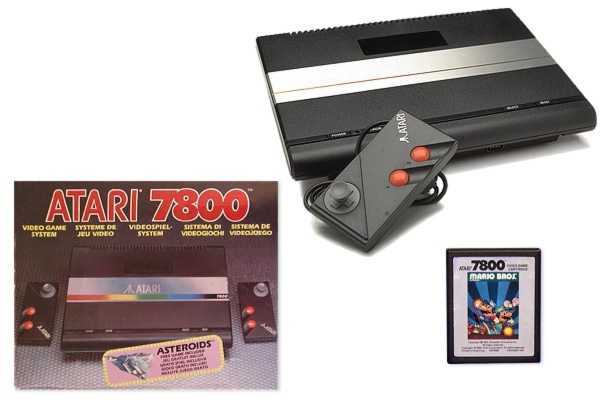
The
Atari 7800 was Atari's chance at redemption in the video game market. Atari Inc.
spent a good part of 1983 interviewing thousands of people on what they wanted
and didn't want in a video game console. Atari Inc. through Warner Communications,
then worked with General Computer Corporation who earlier had lost a lawsuit with
Atari regarding a "Speed-up" board for Atari's Missile Command.
The
all new graphics chip called MARIA (Also the codename of the 7800 Project) with
almost 100 independent sprites, better color palette onscreen, and other powerful
features would not only allow game designers the ability to code new and exciting
games, but the chip also allowed an original Atari TIA processor to co-exist side
by side with MARIA so that the new console could also play all of the original
Atari 2600 games as well.
The
Atari 7800 was designed to be flexible and expandable and even had an expansion
port for future peripherals to tap into the system bus and video circuitry.
Sega
Master System (SMS)
Released in 1986
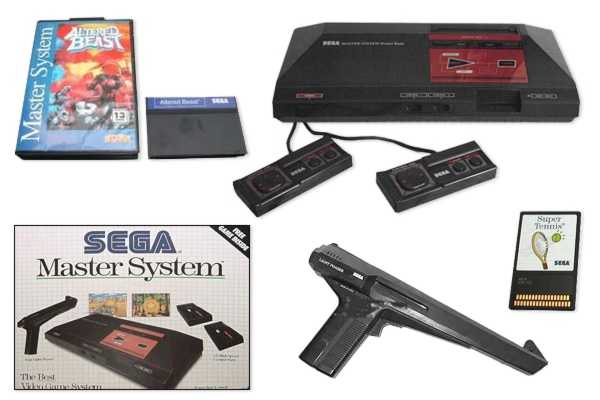
After
producing many games for early home videogame consoles, Sega decided to develop
a console system of its own. The SG-1000 and Mark III were available in Japan
in the mid-1980s, but when Sega witnessed the early success of the Nintendo Entertainment
System, the company knew it wanted a share of the American console market. So,
Sega redesigned the Mark III, renamed it the Sega Master System (SMS for short),
and released it in 1986, not long after the NES first came out.
Technically,
the Master System was superior to the NES, with better graphics and higher quality
sound. The original SMS could play both cartridges and the credit card-sized "Sega
Cards," which retailed for cheaper prices than carts but had less code. The
SMS also had cooler accessories (like 3D glasses), but this didn't do much good
when there weren't very many exciting games.
The
Master System technology lived on in Sega's Game Gear, which was basically a portable
SMS with some enhancements.
NEC Turbo Grafx
16
Released in 1989
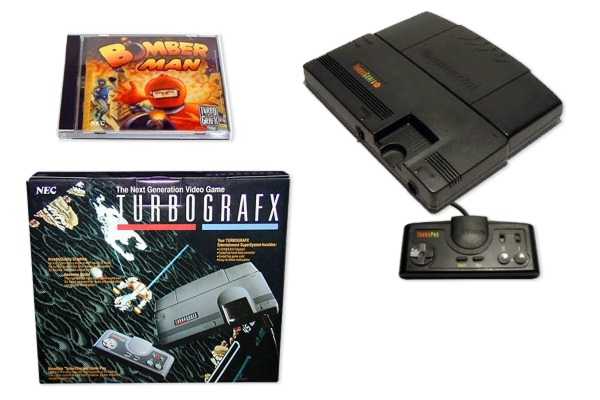
In
Japan, shortly after the introduction of Nintendo's Famicom (Japan's version of
the NES), the electronics giant NEC entered into the videogame market with the
introduction of their "next generation" system, known as the PC Engine
(PCE). The PCE boasted a 16-bit graphics chip capable of displaying up to 256
colors on screen at once, at a number of resolutions. Although its CPU wasn't
much more powerful that of the NES, its spectacular graphics chip and six-channel
sound bettered the Famicom in every way. It utilized a sleek new card format (PCE
games are either HuCards or Turbochips) to hold its software, rather than bulky
cartridges. It was also the first console to boast a CD-ROM drive, for full orchestral
soundtracks and even (gasp!) full motion video. The PC Engine was immensely popular
in Japan, outselling the Famicom by a significant margin.
In
1989, two years after its Japanese introduction, NEC announced plans to bring
the PC Engine overseas, to the booming videogame market of the U.S. With a huge
library of Japanese software, it seemed to many as though the system couldn't
possibly fail.
Sega Genesis
Released
in 1989

It
was 1989. Nintendo's NES had reigned supreme in the videogame market for nearly
five years, and it was time for a new system to take over the throne. Sega's Master
System, while graphically superior to the NES, failed to make any kind of lasting
impression in the U.S. market (although it was very popular in Europe), and Sega
knew that their next system would not only have to be superior to everything else
out there, but they'd have to have a lot of third-party developers lined up.
After
two years of development, Sega introduced their "next generation" system
to the world in late 1989. Known as the Genesis in the West, and the Mega Drive
in the east, Sega began an aggressive marketing campaign, not only to customers,
but also to developers.
Although
NEC's TurboGrafx-16 had beat the Genesis to market by nearly four months, Sega
quickly regained lost ground, thanks to their line-up of quality arcade conversions,
killer sports games, and most of all, the full support of Trip Hawkins and Electronic
Arts.
Sega Master System
II
Released in 1990
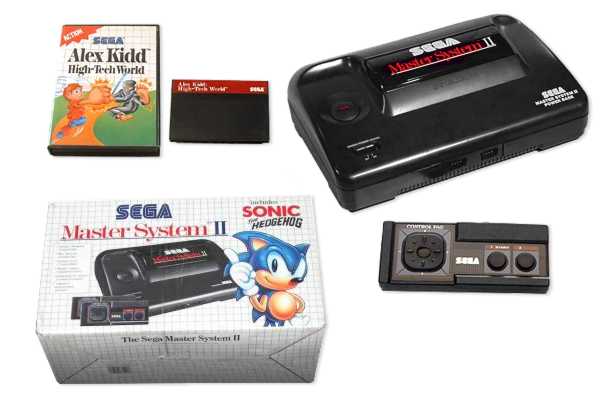
In
1990, Sega was having success with its Sega Mega Drive/Sega Genesis and as a result
took back the rights from Tonka for the SMS. They designed the Sega Master System
II, a newer console which was smaller and sleeker but which, to keep production
costs low, lacked the reset button and card slot of the original. Sega did everything
in its power to market the system, but nothing came out of it.
By
1992, the Master System's sales were virtually nonexistent in North America and
production ceased. Sales were poor in Japan as well, due to the dominance of the
main competitor from Nintendo, the Nintendo Family Computer.
The
Sega Master System is still being produced in Brazil. The latest version is the
"Master System III Collection". It uses the same design as the North
American Master System II (Master System III in Brazil), but is white and comes
in two versions: one with 74 games built-in and another with 105 games built-in
on an internal ROM. But in Brazil it's hard to find the 3D Goggles, the Light
Phaser Pistol and even the cartridge, leaving Brazilians only with the built-in
games.
SNK NEO-GEO (AES)
Released
in 1990
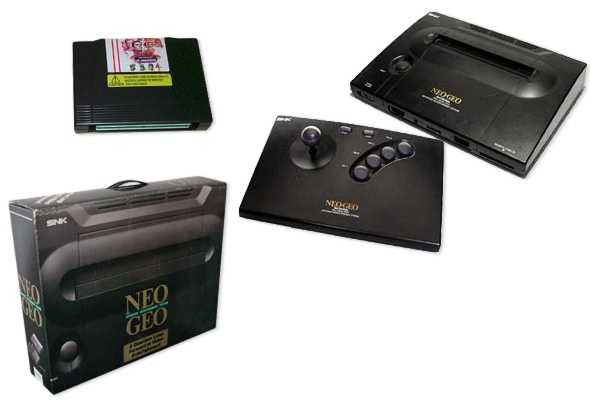
Shin
Nihon Kikaku (SNK) first ventured into the arcade market in 1989 and was successful
with its unique 2D arcade machine, which was powered by an impressive custom graphics
processor, 68000 and Z80 CPUs and offered 330Mbit ROM storage space. This arcade
version was known as MVS, or Multi-Video Output and allowed 1 of 6 games to be
loaded at any time. The Neo Geo AES (Advanced Entertainment System) was a home
version of the Neo Geo MVS and played the exact same games as the ones in the
arcades. In fact, even memory cards could be switched between the two, allowing
players to save their progress on one machine and load it on the other.
The
major weakness of the Neo Geo AES was the high price tag on the cartridges. Most
games sold for about $200! The console itself was also fairly expensive, retailing
at $650. Its arcade-style joystick and excellent arcade ports made it a very attractive
console. A Multi-Link cable was released for the Neo Geo AES that allowed two
Neo Geos to be connected together and be played on two separate televisions.
Super
Nintendo Entertainment System
Released in 1991
.jpg)
The
Super Nintendo Entertainment System was Nintendo's second home console, following
the Nintendo Entertainment System (often abbreviated to NES, released as the Famicom
in Japan). Whereas the earlier system had struggled in Europe and large parts
of Asia the SNES proved to be a global success, albeit one that could not match
its predecessor's popularity in South East Asia and North America - due in part
to increased competition from Sega's Mega Drive console (released in North America
as the Genesis). Despite its relatively late start, the SNES became the best selling
console of the 16-bit era but only after its competitor Sega had pulled out of
the 16-bit market to focus on its 32-bit next generation console.
Nintendo
released the Super Nintendo Entertainment System which initially sold for a price
of $200. The North American package included the game Super Mario World. The SNES
was released in the United Kingdom and Ireland in April 1992 for £150, with
a German release following a few weeks later. The PAL versions of the console
looked identical to the Japanese Super Famicom, except for labelling.
Sega
CD for Genesis
Released in 1992

The
Sega CD had been announced at the Chicago CES on November 1992. Early reports
had suggested that hardware in the system would allow it to display more on screen
colors (from a larger palette) than the Sega Genesis or the Super Nintendo, which
was an important technical concern for consumers.
In
the end, the Sega CD failed to convince North American gamers, mostly due to the
cost of the console, and the lack of any hardware advancements. There just was
not enough value for the price. Moreover, the game experience was little improved.
The
single speed CD drive added load times to all games, and the 64-color graphics
and underpowered processor (for video rendering) made full-motion games look terrible.
One particularly infamous example of this came in the form of the Mortal Kombat
CD, which was widely criticized due to certain moves, particularly the games popular
"fatalities", that would not perform until after a notable lag between
the execution of the move and its acutal on screen animation.
Panasonic
3DO Interactive
Released in 1993
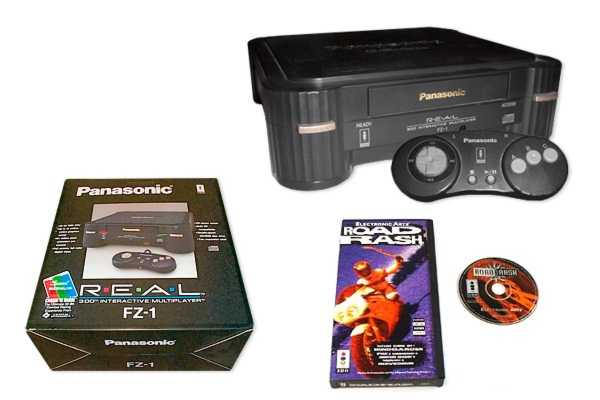
The
3DO was a concept. "Create the blueprints for a next-generation, 32-bit,
do-it-all, set-top system that is fully upgradeable and license the actual hardware
manufacturing to some of the world's largest electronics manufacturers."
That's the 3DO. Trip Hawkins, founder of the 3DO company, joined forces with RJ
Mical and Dave Needle to create the most innovative system of the '90s. The 3DO
was originally designed to be the next step in home entertainment: Audi-o, vide-o,
3D-O. The creators hoped it would become as common as the VCR and as fun and entertaining
as a TV, VCR, CD player, videogame system and computer combined. The idea was
sound. Unfortunately, the execution of the idea was not.
Many
companies obtained licenses to produce 3DO systems, including Goldstar, Sanyo,
Samsung, AT&T, Creative Labs and the world's largest electronics company,
Matsushita/Panasonic. With the idea that the 3DO was to become a multifunctional
part of everyone's home entertainment centers, the unit was released in 1993 with
an MSRP of $700.
Atari Jaguar
Released
in 1993
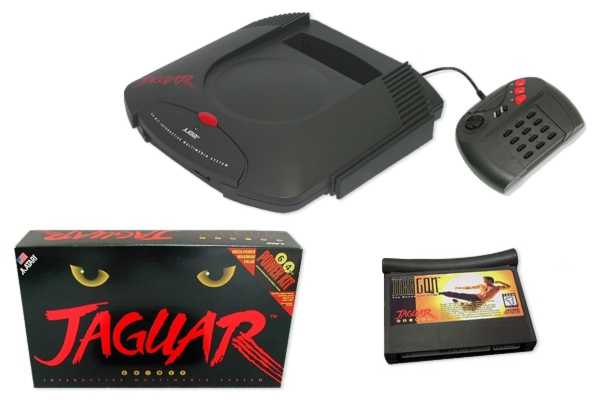
Competing
with Sega and Nintendo's 16-bit consoles, the Jaguar was said to be 64-bit. Back
then, bit width was a big deal in the gaming industry, just as polygon-pushing
power is today. The Jaguar did not work off of a solitary 64-bit processor, but
instead it had a collection of processors with bus widths ranging from 16 to 64
bits. The bit width of the Jaguar is still a source of considerable debate today,
but consensus exists among those who are familiar with the system hardware that,
because Jaguar's main data bus and some of the processors are 64-bit, the entire
system can be considered 64 bit. It would otherwise be considered a 32-bit console.
Nonetheless,
it was technically superior to the leading 16-bit consoles at the time. Unfortunately,
this last ditch effort by Atari to find room in the console market failed. A relatively
small number of games were developed for the system, but Atari pulled the plug
altogether in 1996.
Nintendo Entertainment
System Model 2
Released in 1993
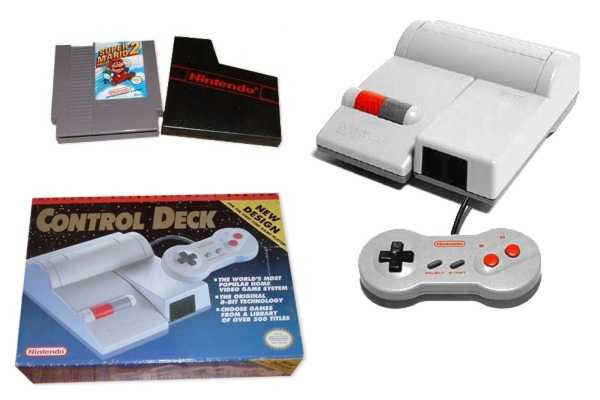
In
1993, Nintendo released a top loading NES model 2. This newer model was scaled
down to nearly half the size of the original. The case was a sleeker design (Like
a smoother Famicom). The cartridge port was more stable, and used eject &
power buttons similar to it's successor the SuperNES. Even the controller had
the "bone-like" shape of the SuperNES. This new model sold for $45.
The cheaper price came at the loss of the original model's interface and A/V output
ports. Nintendo dropped support for this new model a year later. Today, it's a
collectors item.
Nintendo's
success introduced some of the most interesting accessories and conversions. Who
could forget the "Power Glove", and "Rob the Robot". Nintendo
slapped "NES-like" hardware into an Arcade cabinet and released Nintendo
Playchoice to arcades everywhere. In Japan they released a disk drive accessory
that allowed gamers to download games from vending machines onto a disk.
Sega
Genesis 2
Released in 1994
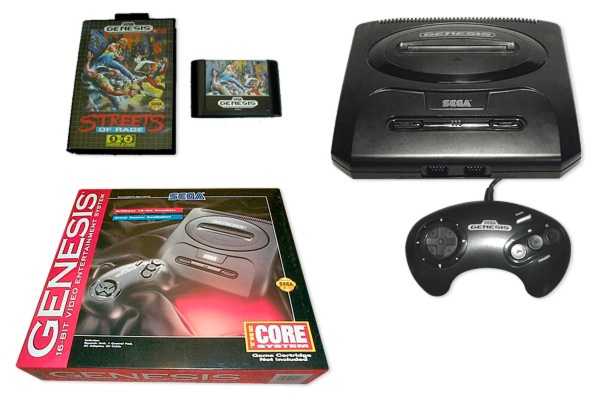
The
Sega Genesis 2 Unit was released in 1994 and was nearly the same as the Sega Genesis
released in 1989. The new unit was absent of a headphone jack and volume control
and used a non standard RF switch and AC adapter. The pack ins were an AC adapter,
RF switch, controller, and the Sonic the Hedgehog 2 game.
The
failures of the Sega CD and 32X, a lack of effective advertising, and disputes
between Sega of America and Sega of Japan had taken their toll on the company.
By 1994, Sega's market share had dropped from 65% to 35%, and the official announcements
of newer, more powerful consoles, such as the Saturn, Playstation, and N64 signaled
that the 16-bit era was drawing to a close. Interest in the Genesis suffered greatly
as a result, compounding its already falling sales. In 1996, less than a year
after the debut of their Saturn console, Sega quickly brought their participation
in the 16-bit era to an end by discontinuing production of the Genesis and its
associated accessories.
Sega CD for Genesis
2
Released in 1994
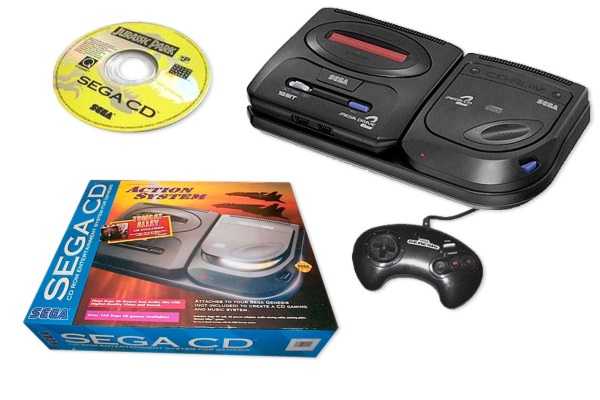
The
Sega Mega-CD is an add-on device for the Sega Mega Drive released in Europe, Australia,
and Japan. The North American version is called the Sega CD. The device allows
the user to both play CD audio discs and specially designed game CDs. It can also
play CD+G discs.
The
development of the Sega CD was top secret; game programmers didn't know what they
were designing for until the Mega-CD was finally revealed at Tokyo Toy Show in
Japan. The Sega Mega-CD in Japan was designed to compete with the PC Engine, which
had a separate CD-ROM drive.
In
the United States, the Sega CD was considered a failure due to its high price,
low sales and general confusion with the Sega 32X, another Genesis peripheral
offered. Due to Sega of America's lack of support for the Sega CD and 32X, many
consumers lost their trust in Sega and it can be said that Sega never recovered
from this, as the Saturn sold poorly and the Dreamcast, although considered a
good effort on Sega's behalf, was unable to compete effectively with the PS2.
Sega
Genesis 32x
Released in 1994
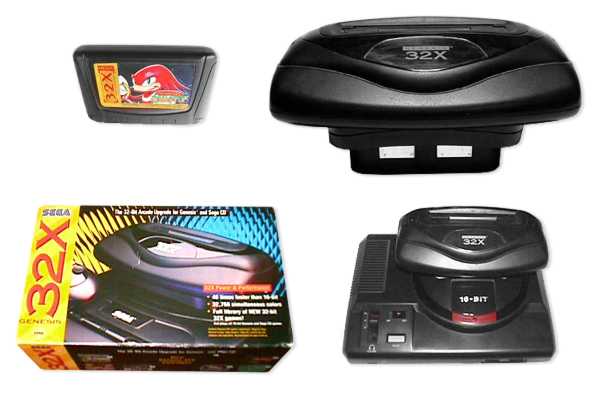
The
32X hit the market in North America in November 1994, during the same month the
Sega Saturn was released in Japan. Many industry insiders speculated that the
32X was doomed from the beginning as the Sega Saturn hardware was widely regarded
as more powerful than the 32X and had the support of many Japanese third party
software developers.
The
Sega 32X can only be used in conjunction with a Sega Mega Drive/Sega Genesis system;
it is plugged in where the cartridge bay is. Besides playing its own cartridges,
it also acted as a passthrough for Genesis games so it would be a permanent attachment.
The 32X came with 10 coupons and several spacers, so it would work with all versions
of the Genesis.
Since
this was an expensive add-on system, Sega decided to bundle in some rebate vouchers,
which were difficult to take advantage of. Orders exceeded one million, but not
enough were produced, and supply shortage problems arose.
SNK
NEO-GEO CD
Released in 1994

The
Neo Geo CD is essentially the same hardware as the AES but with a CD drive instead
of the cartridge slot. CD's are a lot cheaper to produce than cartridges and SNK
passed this saving on to gamers with the Neo Geo CD.
Unfortunately,
the CD drive is single speed and it takes a long time for games to load compared
to cart based games that load instantly. The loading isn't too bad on level based
games such as Metal Slug, but it can be really infuriating on fighting games when
it needs to load every couple of minutes.
Atari Jaguar CD
Released
in 1995
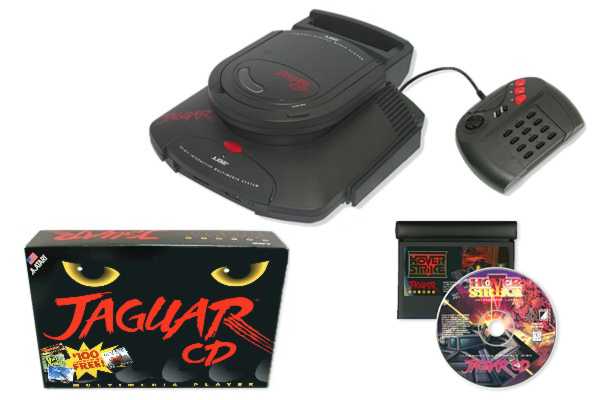
Late
in it's life span, Atari released this long-promised CD-ROM unit. The device sat
atop the Jaguar console, plugging into the cartridge slot, the physical design
of the system sometimes compared to a toilet. The drive had its own cartridge
slot to allow cartridge games to be played without removing the CD drive. There
was a separate "Memory Track" cartridge for storing saved game position
and high scores.
The
Jaguar CD unit featured a double speed (2x) drive and built-in VLM (Virtual Light
Machine) software. The VLM, which provided a sophisticated video light show when
an audio CD was played in the machine, was as popular among buyers as the games
themselves. Packaged with the drive were two games (Blue Lightning and Vid Grid),
a music CD (Tempest 2000 soundtrack), and a Myst demo disc.
The
drive was manufactured for Atari by Phillips in the United States. The initial
shipment was 20,000 units. With the JT Storage reverse takeover looming just a
few months away, it is possible that those 20,000 drives were the only units ever
produced.
Sony PlayStation
Released
in 1995
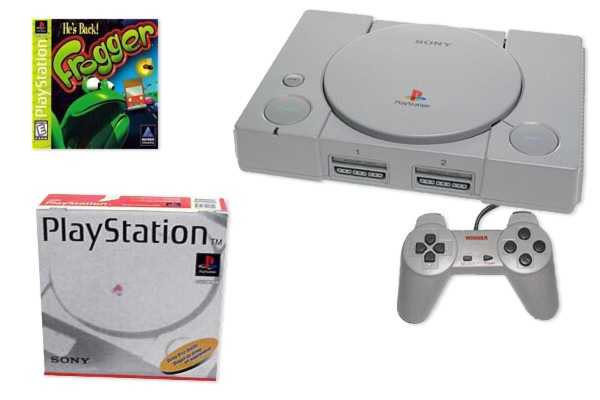
Nintendo
asked Sony to develop a CD-ROM add-on called "PlayStation" for the SNES.
Because Sony wanted 25% of all profits Nintendo earned from sales of this PlayStation
and all PlayStation games, after Sony revealed that they were developing it, Nintendo
instead went to Philips. This caused Sony to consider abandoning their research,
however instead they used what they had developed so far and made it into a full
blown console. This led to Nintendo filing a lawsuit claiming breach of contract
and attempted, in U.S. federal court, to obtain an injunction against the release
of the PlayStation, on the grounds that Nintendo owned the name. The federal judge
presiding over the case denied the injunction.
The
PlayStation was launched in Japan on December 3, 1994, the USA on September 9,
1995 and Europe on September 29, 1995. In America, Sony enjoyed a very successful
launch with titles of almost every genre including Toshinden, Twisted Metal, Warhawk,
and Ridge Racer. Almost all of Sony's and Namco's launch titles went on to produce
numerous sequels.
Panasonic 3DO FZ-10
Released
in 1995
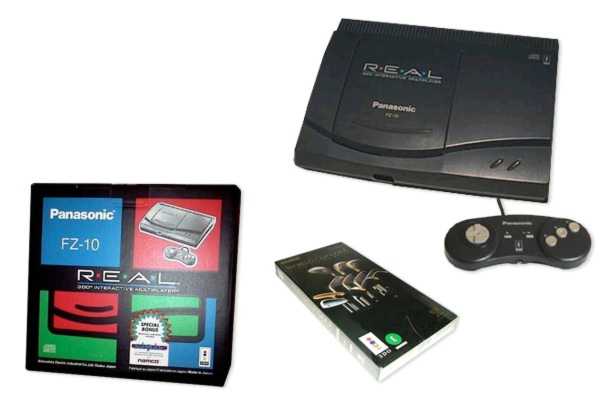
The
3DO sported some very innovative features. The fact that it is a CD-based system
gave developers nearly limitless space to store their games and programs, something
cartridge-based systems lack. There was only one controller port. However, this
wasn't a problem since extra controllers (up to 8) could be easily daisy-chained
as each controller has its own controller port. The original Panasonic controllers
have a built-in stereo headphone jack along with a volume control dial. The system
has its own internal memory to save games and other information. It has 2 expansion
ports which were to be used for future upgrades such as memory cards, modems,
digital video cartridges and the M2 system upgrade.
There
were many accessories for the 3DO, some of them standard (like gamepads, wireless
controllers and a lightgun). Then there were more unique items like the mouse,
steering wheel, flight stick and the Super Nintendo controller adapters which
allowed the cheaper Super NES controllers to be used on the 3DO. However, there
were even more impressive items available that truly allowed the 3DO to stand
alone.
Sega Saturn
Released
in 1995
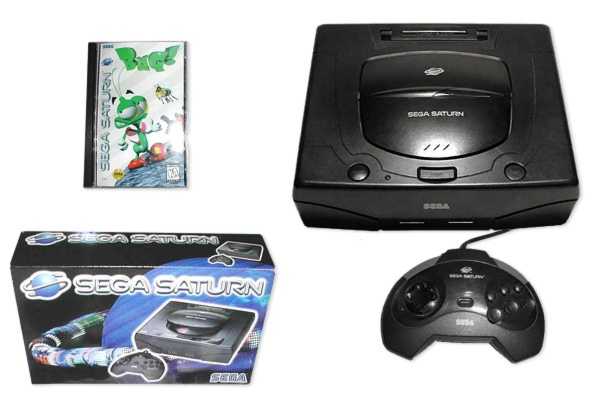
Sega's
Away Team worked for an entire two years exclusively to make certain that the
Sega Saturn was launched with some of the world's best hardware and software.
The 27-member Away Team comprises Sega employees from every aspect of hardware
engineering, product development, and marketing. Their sole mission was to ensure
that Sega Saturn's hardware and design met the precise needs of both the U.S.
and Japanese markets.
In
May 1995, Sega launched the Saturn in the USA, a full four months ahead of schedule.
This was announced at that year's E3 (Electronic Entertainment Expo) where Sega
representatives were engaged in a public relations battle with Sony. This surprise
move resulted in very few sales, however. This was due largely to the $399 USD
price of the system and the lack of available software at time of launch. Also,
Sega chose to ship Saturn units only to four select retailers. This caused a great
deal of animosity toward Sega from unselected companies, including Wal-Mart and
KB Toys.
Nintendo 64
Released
in 1996
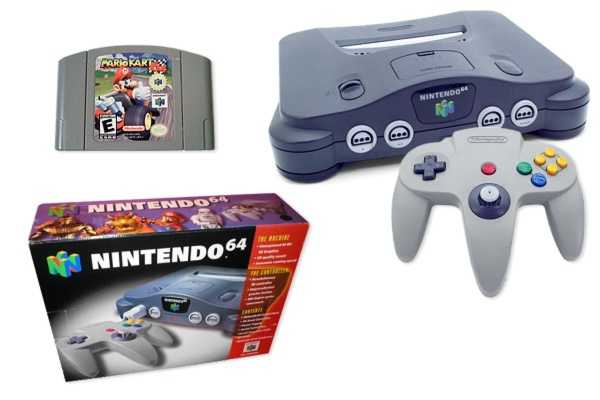
The
Nintendo 64, commonly called the N64, is Nintendo's third home video game console.
The N64 was released on June 23, 1996 in Japan, September 29, 1996 in North America,
1 March 1997 in Europe/Australia and September 1, 1997 in France. It was released
with only two launch games in Japan and North America (Super Mario 64 and PilotWings
64) while Europe had a third launch title in the form of Star Wars: Shadows of
the Empire (which was released earlier in the other markets). The Nintendo 64
cost $199 at launch in the United States.
During
the developmental stages the N64 was referred to by its code name, Project Reality.
The name Project Reality came from the speculation within Nintendo that this console
could produce CGI on par with then-current supercomputers. Once unveiled to the
public the name changed to Nintendo Ultra 64, referring to its 64-bit processor,
and Nintendo dropped "Ultra" from the name on February 1, 1996, just
five months before its Japanese debut.
Super Nintendo
Entertainment System 2
Released in 1997
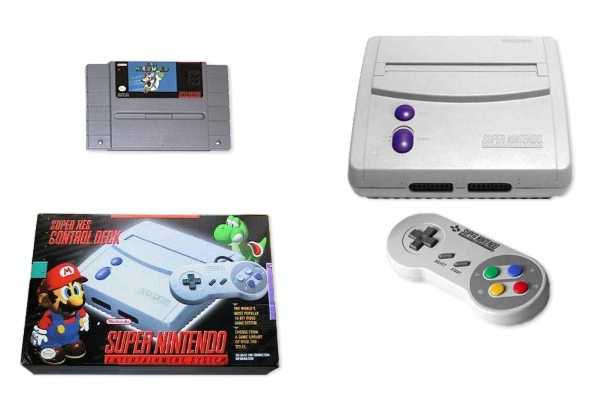
By
1996, the 16-bit era of gaming had ended, and a new generation of consoles, including
Nintendo's own Nintendo 64, caused the popularity of the SNES to wane. In October
1997, Nintendo released a redesigned SNES 2 in North America for $99 USD (which
included the pack-in game Super Mario World 2: Yoshi's Island). Like the earlier
NES 2, the new model was designed to be slimmer and lighter than its predecessor
but lacked S-Video and RGB output, and would prove to be among the last major
SNES-related releases in America.
Nintendo
of America ceased production of the SNES in 1999. In Japan, the Super Famicom
continued to be produced until September 2003 (also some new games were produced
until the year 2000). In recent years, many SNES titles have been ported to the
handheld Game Boy Advance, which has similar video capabilities. Some video game
critics consider the SNES era "the golden age of video games," citing
the many groundbreaking games and classics made for the system, whereas others
question this romanticism. See video game player for more.
Sega
Genesis 3
Released in 1998
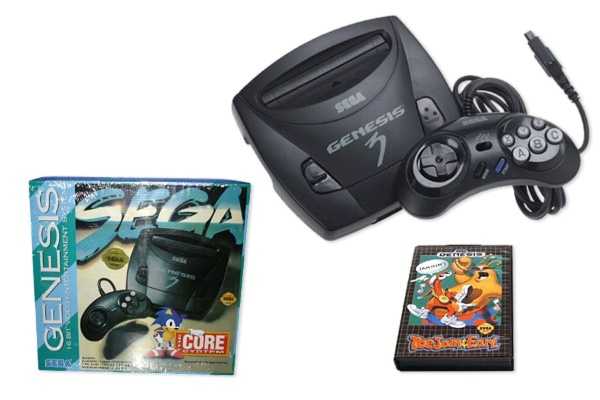
A
company by the name of Majesto started to take over manufacturing of systems for
Sega in 1998 with their release of the Genesis 3. The system retailed for $29.99
and came packaged with one controller, AV cables, and a power cord. The controller
that was featured as a pack in was the new Sega six button controller. The system
itself was very tiny, about the size of two controllers for the system. The system
lacked the expansion port that the Genesis 1 and Genesis 2 had and thus could
not utilized the function of the Sega CD 1 or 2. The Genesis 3 could not utilize
the 32X either.
Besides
redesigning the Sega Genesis, Majesto also re-released certain games for the system.
They came in cardboard boxes with black and white instructions. Majesto had also
done some re-releasing for the Sega Game Gear and the Super Nintendo. At the same
time they were doing work with the Game Gear, they had plans to re-release the
Sega Saturn, but as of yet, nothing has been done. The following games do not
work (per Genesis 3 Instruction Manual): Virtua Racing. The Sega Channel Modem
also does not work.
Sega Dreamcast
Released
in 1999
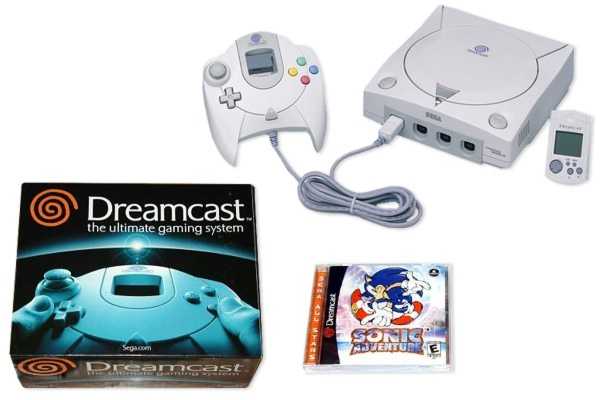
The
Dreamcast was released on November 27, 1998 in Japan, on September 9, 1999 in
the United States (the date 9/9/99 featured heavily in US promotion) and on October
14, 1999 in Europe. The tagline used to promote the console in the US was "It's
thinking", and in Europe "Up to 6 Billion Players". (The vagueness
of these campaigns and almost total lack of any in game footage has been touted
as one of the reasons for the Dreamcast's eventual downfall. Many Americans knew
that the Dreamcast was coming, but didn't know what one was.)
The
Dreamcast was the first console to include a built-in modem and Internet support
for online gaming. It enjoyed brisk sales in its first season and was one of Sega's
most successful hardware units. In the United States alone, a record 200,000 units
had been pre-ordered before launch and Sega sold 500,000 consoles in just two
weeks (including 225,000 sold on the first 24 hours which became a video game
record until the PlayStation 2 launched a year later). In fact, due to brisk sales
and hardware shortages, Sega was unable to fulfill all of the advance orders.
Sony
PlayStation PS1
Released in 2000
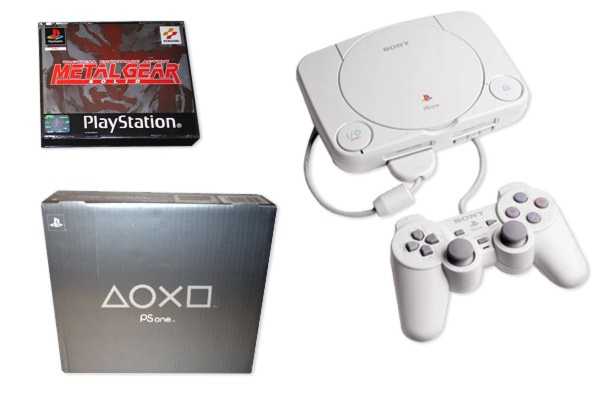
The
first new version was actually a revision in early 1996, produced in response
to complaints that PlayStations were overheating. Sony did not change the technical
aspects or the cosmetics, but did remove the S-video port left over from the Japanese
release.
Sony
produced a redesigned version of the original console, called the "PSone",
in a smaller (and more ergonomic) case which was introduced in September 2000.
The original PlayStation was abbreviated in Japan to "PS" and was often
abbreviated as "PSX" by American gamers, as this was Sony's internal
code name for the system while it was under development. This led to some confusion
in 2003, when Sony introduced a PS2-derived system in Japan actually called the
PSX. The PlayStation is now officially abbreviated as the "PS1" or "PSone,"
although many people still abbreviate it "PS" or "PSX". There
were only 2 differences between the "PSone" and the original, the first
one being cosmetic change to the console, and the second one was the home menu's
Graphical User Interface.
Sony PlayStation
2 (SCPH-5000x)
Released in 2000
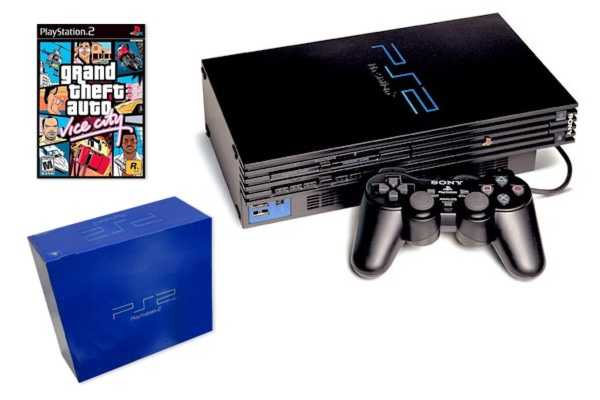
The
PlayStation 2 had a difficult start. Only a few million users had obtained consoles
by the end of 2000 due to manufacturing delays. The PlayStation 2 was such a hot
item after its release that it was near impossible to find one on retailer shelves,
leaving those wanting a PlayStation 2 to either wait or purchase the console online
at sites such as eBay, where the console was being sold by many people for twice
and sometimes five times as much as the manufacturer's listed price.
The
PlayStation brand's strength has lead to strong third-party support for the system.
Although the launch titles for the PS2 were unimpressive in 2000, the holiday
season of 2001 saw the release of several best-selling and critically acclaimed
games. Those PS2 titles helped the PS2 maintain and extend its lead in the video
game console market, despite increased competition from the launches of the Microsoft
Xbox and Nintendo GameCube. In several cases, Sony made exclusivity deals with
publishers in order to pre-empt its competitors.
Nintendo
Game Cube
Released in 2001

Unveiled
during Spaceworld 2000, the Nintendo GameCube was widely anticipated by many who
were shocked by Nintendo's decision to design the Nintendo 64 as a cartridge-based
system. Physically shaped similar to a geometric cube, the outside casing of the
Nintendo GameCube comes in a variety of colors, such as indigo, platinum, and
black (also a limited edition Resident Evil 4 platinum and black game console).
The
Nintendo GameCube uses a unique storage medium, the GameCube Optical Disc, a proprietary
format based on Matsushita's optical-disc technology; the discs are approximately
8 centimeters (3 1/8 inches) in diameter (considerably smaller than the 12cm CDs
or DVDs used in competitors' consoles), and the discs have a capacity of approximately
1.5 gigabytes. The disc is also read from the outer-most edge going inward, the
opposite of a standard DVD. This move was mainly intended to prevent piracy of
GCN titles, but like most anti-piracy technology, it was eventually cracked.
Microsoft
X-Box
Released in 2001
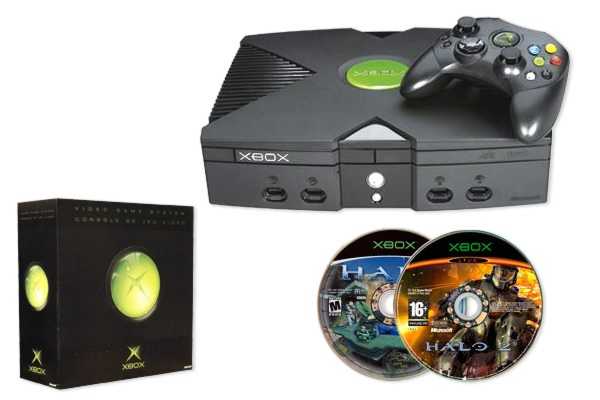
The
Microsoft Xbox is a sixth generation era video game console first released on
November 15, 2001 in North America, then released on February 22, 2002 in Japan,
and later on March 14, 2002 in Europe. The Xbox was Microsoft's first independent
venture into the video game console arena, after having developed the operating
system and development tools for the MSX, and having collaborated with Sega in
porting Windows CE to the Sega Dreamcast console. Notable launch titles for the
console include Amped, Dead or Alive 3, Halo: Combat Evolved, Oddworld: Munch's
Oddysee, and Project Gotham Racing.
In
November 2002 Microsoft released the Xbox Live online gaming service, allowing
subscribers to play online Xbox games with (or against) other subscribers all
around the world and download new content for their games to the hard drive. This
online service works exclusively with broadband. 250,000 subscribers had signed
on in 2 months since Live was launched. In July 2004, Microsoft announced that
Xbox Live reached 1 million subscribers, and announced in July 2005 that Live
had reached 2 million.
Sony PlayStation
2 (SCPH-70000)
Released in 2004
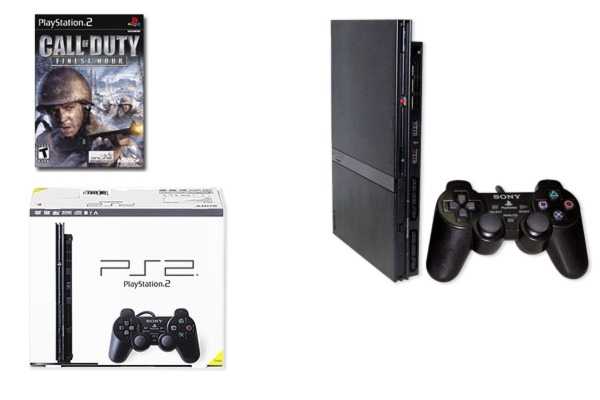
In
September of 2004, in time for the launch of Grand Theft Auto: San Andreas (the
best-selling game during the 2004 Holiday season), Sony revealed a new, smaller
PS2. In preparation for the launch of a new, slimmer PlayStation 2 model (SCPH-70000),
Sony had stopped making the older PS2 model (SCPH-5000x) sometime during the summer
of 2004 to let the distribution channel empty out stock of the units. After an
apparent manufacturing issue caused some initial slowdown in producing the new
unit, Sony reportedly underestimated demand, caused in part by shortages between
the time the old units were cleared out and the new units were ready. This led
to further shortages, and the issue was compounded in Britain when a Russian oil
tanker became stuck in the Suez Canal, blocking a ship from China carrying PS2s
bound for the UK. During one week in November, sales in the entire country of
Britain totalled 6,000 units — compared to 70,000 a few weeks prior. Shortages
in North America were also extremely severe; one retail chain in the U.S., GameStop,
had just 186 PS2 and Xbox units on hand across more than 1700 stores on the day
before Christmas.
XaviXPORT
Released
in 2004
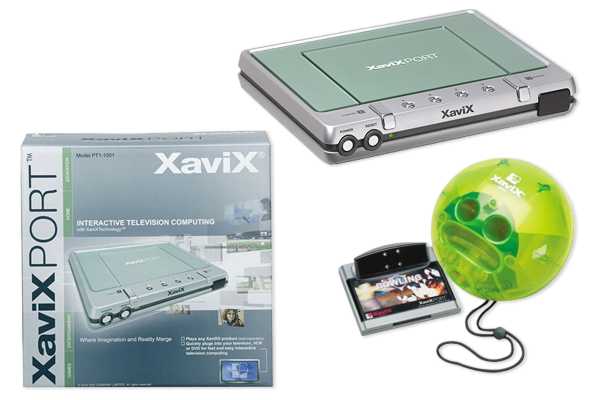
In
January at the Consumer Electronics Show 2004 (CES), SSD COMPANY LIMITED debuts
their XaviX® technology to the American public. The XaviXPort console was
officially released in the US in August of 2004.
XaviXPort
is a unique and innovative console that uses peripherals to interact with onscreen
games. The console contains image recognition and infrared sensors that can detect
player movements. These movements are calculated by a proprietary multiprocessor
that measures both velocity and angle. The multiprocessor then translates the
actions into onscreen movement.
Getting
players to immerse themselves into games with body movements is not something
new. However, this is the first time a console has been dedicated to providing
this "Get your butt off the couch" interactive gaming experience. What
makes XaviXPort even more unique is that the console’s multiprocessor is
not installed inside the system itself. The multiprocessor can be found in each
game cartridge.
Microsoft X-Box
360
Released in 2005

The
Xbox 360 is Microsoft's newest video game console, the successor to their original
Xbox. It was released on November 22, 2005 in North America, December 2 in Europe,
and December 10 in Japan. It will be released on February 2, 2006 in Mexico, February
24 in South Korea, and March 2, 2006 in Australia, New Zealand, Hong Kong, Taiwan
and Singapore.
The
Xbox 360 will compete against the upcoming generation of consoles, including the
Sony PlayStation 3 and Nintendo Revolution, and was officially unveiled on MTV
on May 12, 2005, a week before the E3 trade show.
Except
in Japan the console is sold in two different configurations: the "Xbox 360"
and the "Xbox 360 Core System". The Xbox 360 configuration, often referred
to as the "Premium Edition", includes a hard drive (required for backwards
compatability with original Xbox games), a wireless controller, a headset, an
Ethernet cable, an Xbox Live silver subscription, and a component HD AV cable
(which can also be used on non-HD TVs).
A
BIG thanks to Ian for contributing this article to Good Deal Games.
Be
sure to visit The GAME CONSOLE website
Contact
Ion
Hatzithomas
